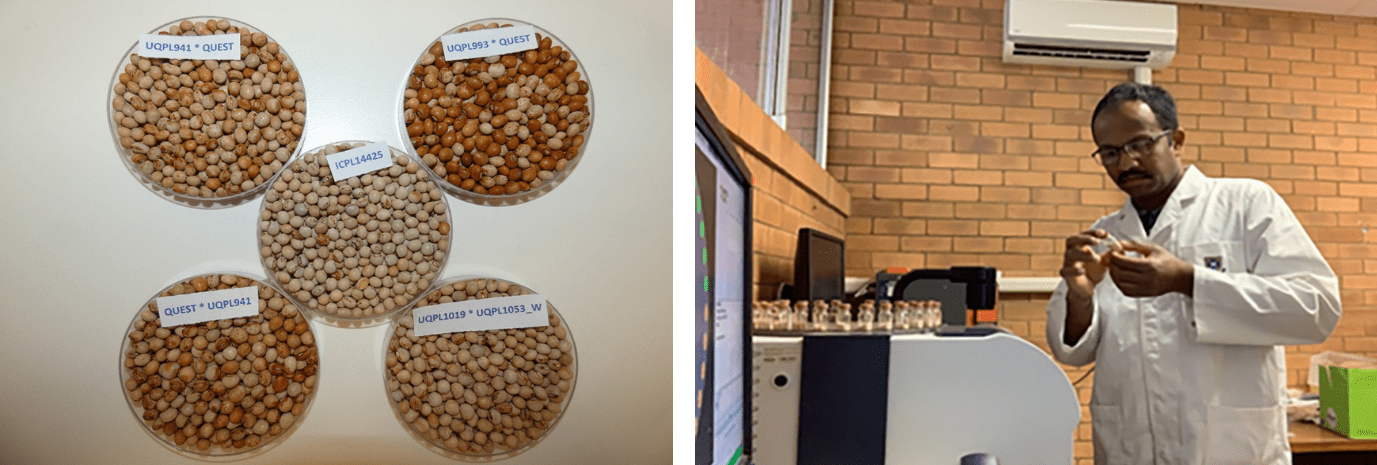

Physiological determinants of yield potential of pigeonpea, TropAg
October 24, 2022
The Crawford Fund’s Queensland Committee has again partnered with the TropAg International Agriculture Conference to assist 10 young researchers from developing countries attend and present their science at this international conference which will be held in Brisbane from 31 October to 02 November 2022.
Successful candidates were chosen by a selection panel made up of representatives of The Crawford Fund and the TropAg conference organisers, based on submitted abstracts of their research.
In the lead-up to the conference we will be publishing short blog posts written by the young researchers about their work. Here is the eighth blog.
By Mahendraraj Sabampillai, QAAFI, The University of Queensland.
Changing jobs is never easy and moving from work environments as contrasting as academia and industry represents unique challenges. After completing my undergraduate degree then a Master (MBA), I held senior management positions in corporate entities before returning to academia to start PhD. Although this might not be a conventional route, it has given me a unique experience and opportunity to manage a wide variety of complex and multifaceted research projects and to find practical solutions. I am very passionate in working as a research scientist and wanted to develop this career path further.

This study aimed to understand the nature and magnitude of genotype × environment (temperature, photoperiod and radiation) interactions on growth and reproductive development of pigeonpea genotypes. Pigeonpea [Cajanus cajan (L.) Millsp.] is a popular food legume crop originating from India and grows well in tropical and subtropical environments extending between 30 o N and 30 o S latitude. Traditionally pigeonpea is intercropped with cereals (sorghum, maize, and millet), other legumes (groundnut, mung bean and soybean) and long season annuals (cotton). Recent studies in Queensland, Australia have demonstrated the high productive performance of pigeonpea. The grain industry perceives this crop as one of the profitable summer legume options for dryland growers in the tropical and subtropical regions in Northern Grains Region.

There is a wide range of maturity classes such as extra-short (<105 days), short (105 – 145 days) medium (146 – 199 days) and late maturing (>200 days) in pigeonpea. Growing environment plays an important role in determining the crop yield. The interaction between genotype, maturity class and growing environment are critical in optimising grain yield in pigeonpea. The effects of temperature, photoperiod and radiation on flowering and reproductive development of pigeonpea need to be updated for new genotypes.
Updated information provided in this study on germination, seedling emergence, flowering, pre- and post-flowering vegetative DM accumulation and priorities in DM partitioning into various plant parts is useful to widen pigeonpea into new production systems.
The study defined the base (Tb), optimum (To) and maximum (Tm) temperatures for germination and emergence as 8.4 ℃ and 10.8 ℃, 37.9 ℃ and 33.8 ℃, and 47.0 ℃ and 33.8 ℃, respectively. The predicted critical photoperiod for photoperiod sensitive genotypes ranged from 12.4 – 13.4 hrs which shows that, in South-east Queensland, plantings in late spring and early summer in October and December, extra-early genotypes flower in 50 – 60 days, whereas early and late flowering genotypes in 60 – 80 days.
The study also revealed that grain yield of pigeonpea genotypes was positively correlated with leaf area duration (r2 = 0.81), (the time to reach maximum LAI) and seasonal RUE (r2 = 0.62). The relationship was stronger during reproduction phase (r2 = 0.83). Seasonal RUE of high yielding genotypes (Quest and ICP 14425) was higher (1.16 g/MJ) than low yielding genotype QPL 1001 (0.99). The results of this study suggest that maintaining an optimum canopy during the pod filling stage is instrumental for high yield potential in pigeonpea genotypes. Understanding of physiology of growth and yield development of pigeonpea genotypes is important for selecting appropriate genotypes for specific environments to optimise yield with a shorter growing period.




